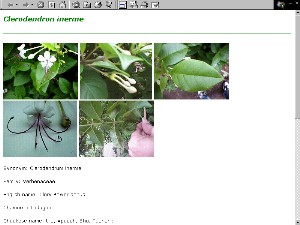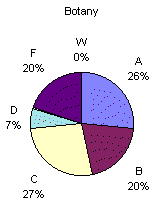
This work was supported by the United States Department of Education Title III Strengthening Institutions Grant.
Computers can be used to deliver content to students via Computer Aided Instruction
packages. In this mode the student is the receiver of information and the computer is the
provider of information. Computers can also be used as a knowledge construction tool by
students. In this mode the student is the provider of the information and the computer
software supports ways to disseminate the information. The later mode of computer use
supports the students as builders of their own knowledge. 
In a traditional Botany course the students prepare herbarium sheets. Herbarium sheets are sheets of heavy paper with a mounted plant and a plant description. Each term the students collect a set number of species of plants, mount each specimen, write up a description, and then hand in their collection. The instructor grades the sheets and then the sheets are either discarded or filed in a drawer in the basement of some remote building.
In the Fall of 1998 the SC 250 Botany course students used a digital camera and a flat bed scanner to capture digital images of plant specimens. The students then used Microsoft FrontPage to construct herbarium pages using HyperText Markup Language. The "virtual" herbarium pages were then posted to a site on the Internet where they remain to the present time. The students' work is globally accessible and contributes to the pool of information about the unique natural world of Pohnpei.
The students had to learn both botanical and technical concepts during the project. Although the technology represented additional learning and work for the students, the students felt that the use of technology and the building of virtual herbarium pages made the course more interesting and exciting.
| Question | % of respondents responding yes (n=10) |
|---|---|
| Should "virtual" herbarium pages, the building of web plant pages be done in future botany course? | 80% |
| Did the use of computer technologies make the course more interesting to you? | 100% |
| Do you feel that the use of technology has increased your own interest in botany? | 100% |
The students were also able to contribute their own local knowledge to the project by adding local names for the flora and by including local medicinal uses for some of the plants. This aspect promoted a sense of knowledge ownership among the students.

The success rate in the Botany course was quite good with 73% of the class passing with a C or higher (n=15). Throughout the term the students acted in a manner that suggested high level of motivation.
| Goal | Accomplishment |
|---|---|
| Develop and implement content and academic support package customized to our science courses with a local content focus. | Developed and implemented local content academic support package for SC 250 Botany. Content can be added to and extended by future courses. |
| Provide a software environment in which faculty can contribute their expertise and knowledge to the science course support materials. | Software environment has as low a learning curve as can reasonably be expected. Only basic scanning, digital photography, and WSIWYG HTML page editing skills required of the instructor. |
| Provide a software environment in which students can contribute to the collecting of local science related knowledge. | Students collected specimens and prepared their own HyperText Markup Language Pages. |
| Provide a dynamic software environment that will grow and change to meet the science knowledge needs of the college and community. | Environment is not subject specific nor are proprietary software or protocols in use. Elements such as the scanners and cameras can be individually upgraded. HTML authoring capacity is becoming ubiquitous with its inclusion as a format generated by many word processors. Main authoring environment, Microsoft FrontPage Editor, is presently free of charge. |
| Create a scientific information resource of benefit to the broader FSM community. | The collection of plant specimen pages acts as the beginning of a biodiversity catalog. If expanded in the future, then the "virtual herbarium" pages could be a true scientific information resource. |
| Create a source of science information for access by remote users both in the FSM and abroad. | The collection is available to anyone with Internet access. |
Botany home page
Lee Ling home